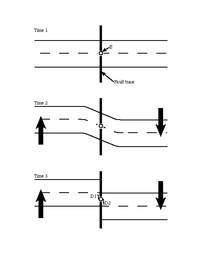Elastic-rebound theory

Imagine playing with a slingshot. You pull back the rubber band as far as you can, and then you let it go. What happens? The rubber band quickly flies forward and snaps back into place, right? That is kind of like what happens in elastic-rebound theory.
So, let's imagine that the Earth is like a big rubber band, but it is made up of huge chunks of rock. These chunks of rock are called tectonic plates. These plates are not stuck together. They can move around, kind of like puzzle pieces on a table.
However, sometimes these puzzle pieces get stuck. They can't move past each other. This is because they are locked together by friction. This is called the "fault line."
But the Earth's crust wants to move. It wants to find a way to release all this built-up energy and start moving again. This is where elastic-rebound theory comes in.
When the Earth's crust becomes strained and builds up a lot of energy, it's like pulling back the rubber band. Eventually, the built-up energy gets so strong that the fault line can no longer hold it and the plates suddenly slip past each other. This is called an earthquake.
Just like when you let go of the slingshot, the tectonic plates snap back into their original position. This is called the elastic rebound. The energy that was stored up is released, causing the ground to shake and create seismic waves.
During an earthquake, the tectonic plates quickly move back to their original position. The energy is released and radiates out in the form of seismic waves, causing the shaking that we feel during an earthquake.
So, whenever the Earth's crust becomes strained and energy is built up, the elastic-rebound theory helps us understand how earthquakes happen. It's kind of like the snap-back of a slingshot, but on a much bigger scale!
So, let's imagine that the Earth is like a big rubber band, but it is made up of huge chunks of rock. These chunks of rock are called tectonic plates. These plates are not stuck together. They can move around, kind of like puzzle pieces on a table.
However, sometimes these puzzle pieces get stuck. They can't move past each other. This is because they are locked together by friction. This is called the "fault line."
But the Earth's crust wants to move. It wants to find a way to release all this built-up energy and start moving again. This is where elastic-rebound theory comes in.
When the Earth's crust becomes strained and builds up a lot of energy, it's like pulling back the rubber band. Eventually, the built-up energy gets so strong that the fault line can no longer hold it and the plates suddenly slip past each other. This is called an earthquake.
Just like when you let go of the slingshot, the tectonic plates snap back into their original position. This is called the elastic rebound. The energy that was stored up is released, causing the ground to shake and create seismic waves.
During an earthquake, the tectonic plates quickly move back to their original position. The energy is released and radiates out in the form of seismic waves, causing the shaking that we feel during an earthquake.
So, whenever the Earth's crust becomes strained and energy is built up, the elastic-rebound theory helps us understand how earthquakes happen. It's kind of like the snap-back of a slingshot, but on a much bigger scale!
